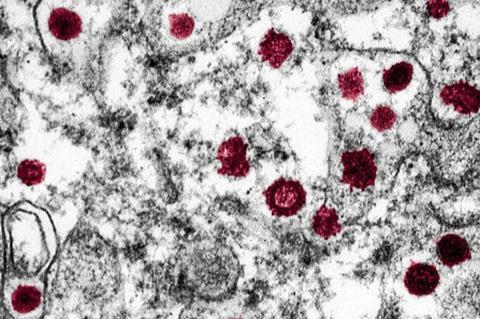A new transatlantic collaboration between the U.S. Army Medical Research Institute of Infectious Diseases (USAMRIID) and LifeArc will look to develop an affordable and accessible monoclonal antibody therapeutic for Crimean-Congo Hemorrhagic Fever Virus (CCHFV), which could treat and protect thousands of people globally.

Dr. Aura Garrison, Dr. Joseph Golden and their colleagues from USAMRIID discovered the antibody in mice during a study first published in 2019 in Science Advances. With LifeArc’s funding and scientific support, they now hope to produce a fully humanized antibody therapeutic ready for Investigative New Drug submission to the U.S. Food and Drug Administration and Phase I clinical trials.
READ MORE: New study sheds light on the causes of fevers of unknown origin in sub-Saharan Africa
READ MORE: Researchers develop promising Lassa fever vaccine
Monoclonal antibodies (mAbs) are among the most effective treatments in modern medicine, but they are also some of the most expensive and are under-utilised for infectious disease. Around 80% are sold in the US, Canada and Europe, with limited access to mAb treatments in many low- and middle-income countries (LMICs). The collaboration between LifeArc and USAMRIID is a step towards enabling global access to treatments for both civilians and military populations in high-risk areas, with a specific focus on those in LMICs.
High mortality
CCHFV is endemic in Africa, the Balkans, the Middle East, and Asia. The U.S. Centers for Disease Control and Prevention estimate that 10,000-15,000 cases occur every year with high mortality rate (up to 40%). CCHFV tick-vector is also spreading into new geographical locations, including western Europe. During seasonal outbreaks, medical professionals are especially vulnerable to infection from patients.
From a biodefense perspective, the U.S. military is interested in protection against CCHFV of personnel stationed in high-risk areas. Currently, there are no approved therapeutic or prophylactic treatments available. CCHFV is designated as a biosafety level 4 (BSL4) pathogen, requiring the highest level of containment and safety measures.
It is also considered a Category A bioterrorism/biological warfare agent, which further hurdles research and development efforts. From a Global Health perspective, LifeArc is interested in accelerating affordable, innovative products for infectious disease that address LMIC priority unmet needs.
Steps forward
Building on LifeArc’s successful track record in antibody humanisation, including the development of one of the world’s most successful cancer drugs, pembrolizumab, and the Alzheimer’s drug lecanemab, the LifeArc research team will engineer USAMRIID’s mAb and screen hundreds of humanized variants against different CCHFV strains to identify the most promising mAb. While LifeArc will lead pre-clinical drug metabolism and pharmacokinetic studies to determine the mAb pharmacological characteristics and properties, USMARIID will leverage their expertise and BSL4 capabilities to test the lead mAb efficacy in a CCHFV infection model in mice. The project will also fund USAMRIID for the development of a biological marker, essential for clinical testing.
With LifeArc financial support (over $2 million), USAMRIID will lead CMC development of the novel CCHFV therapeutic mAb, however the project will also support a clinical development roadmap for accessible mAb therapies. This will include early engagement with the World Health Organization, regulatory agencies and endemic countries to establish a Target Product Profile that ensures suitability for use in LMICs.
Accessible treatments
Ghada Zoubiane, Head of Global Health, LifeArc, said: “This project has the potential to improve thousands of lives. By funding the development of monoclonal antibody therapeutics and implementing measures to make sure they are accessible in endemic regions, we are contributing to a more equitable global healthcare system. Our mission is not only to advance medical research but also to ensure that new treatments are accessible to those who need them most, regardless of location or wealth.”
Dr. Golden explains: “An antibody product capable of affording both therapeutic and prophylactic protection against CCHFV would be a net benefit for world health, as it would limit disease severity in infected individuals, but also protect medical care providers from becoming infected.”
“It is exciting to be part of this research,” says Dr. Garrison. “USAMRIID has been working with CCHFV for decades, and we finally have the tools needed to develop human products capable of mitigating this disease. Protective antibodies against viruses are often able to neutralize the virus; however, neutralizing antibodies do not play a key role in protection against CCHFV. In fact, it was surprising that GP38, which is not a target of neutralizing antibodies, turned out to be a critical protein for protective antibodies.”
USAMRIID’s extensive CCHFV research has focused on understanding how the virus causes disease, developing preventive vaccines, and creating therapeutics that prevent and treat viral infection. The Virology Division supports discovery of both specific and broad-spectrum medical countermeasures against viral threats. Research areas include molecular virology, cell biology, immunology, viral virulence factor determination, and viral strain diversity characterization. It also supports FDA licensure requirements by studying the natural history of disease and pathogenesis.
Topics
- Aura Garrison
- biodefense
- biological warfare
- bioterrorism
- Crimean-Congo Hemorrhagic Fever Virus
- Disease Treatment & Prevention
- Ghada Zoubiane
- Industry News
- Infection Prevention & Control
- Infectious Disease
- Joseph Golden
- LifeArc
- monoclonal antibodies
- One Health
- U.S. Army Medical Research Institute of Infectious Diseases
- UK & Rest of Europe
- USA & Canada
- Viruses







No comments yet